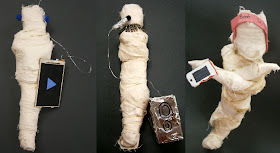Toy Story with Windows Movie Maker
Students Use Writing and Photography to Create an Original Movie
Inspired by Disney's movie A Toy Story, I have created a digital photography lesson plan in which students must create their own toy tale/adventure and turn it into a short video. After spending some time writing our stories (contact me if you'd like the full lesson plan) we plan our photographs. Each page of text (written like a children's story so one page is only a few sentences long) needs to have one photograph to go along with it. The students have a box of random objects and toys I provide or they can supply their own toys. They take the images they need and edit them to fit their story. Some students superimpose multiple images together, and other students make due with what they have at hand.We type up our story and import all of our text and images into Windows Movie Maker. The students really enjoy this program and it's exciting for them to see how they can transform still images into a video. I teach the students how to time each slide, how to add various effects and transitions as well as how to incorporate music using clipping and fading. I never get tired of watching their finished movies! They are so unique and strange in the best kind of way!
Finished examples:
These are the guidelines I give my students:
A Toy Story
Telling a Story
Through Photographs
You are going to write a 12-15 page story about a toy that
has come to life and had its own adventure/day out. For each page that you write you will also
have to stage a scene and photograph it to go along with the text (If you wrote
12 pages, you will take 12 photographs.
If you wrote 15 pages, you will take 15 photographs). The “pages” are not full page word
documents. It can simply be one or two
sentences that describe what is going on.
This is similar to a children’s picture book, there is not a lot of
text, but it gives us just enough information to understand what is
happening. However, you will be using
the parts of a story to demonstrate understanding through the use of a
beginning, middle and an end.
First, you will write your short story (have fun with it and
make it interesting). You will then be
given a toy (you are responsible for these toys and must return them in their
original condition) or you can use/provide your own toys to be used in this
project. You can use class time to take
photographs or do them on your own. You
may use any editing tools to enhance your images, including altering them as we
did with our Surrealism assignment. Your
job is to create a series of scenes in which the toys have become a part of
everyday life. If you have seen the
movie Toy Story, then it’s just as though the toys have come alive and are
roaming around amongst us. You will
stage them in an interesting manner and take a series of digital photographs to
document their adventure. You may edit
your image(s) with www.Pixlr.com/editor if you would like. Be sure to pay close attention to your angles
with this kind of photography. Have
fun! Be Creative!
We will turn your images and text into a PowerPoint
Presentation which we will then convert into a movie using Windows Movie
Maker. These steps will described and
taught to you as you continue the assignment.










































